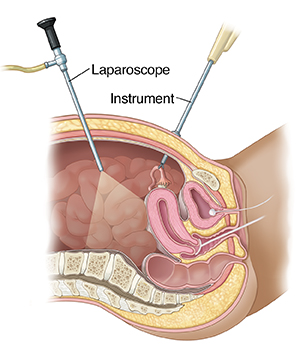Pelvic Laparoscopy
Laparoscopy is a type of surgery done using very small incisions. This type of surgery is possible because of the laparoscope. This is a long, slender tool with a camera and a light. It lets a surgeon see inside your stomach. To do the surgery, the surgeon puts special instruments into the stomach through small incisions. Pelvic laparoscopy is often used to diagnose and treat the causes of pelvic problems, such as pain and infertility. Laparoscopy often involves:

Getting ready
To prepare for surgery:
-
Tell your surgeon about any medicines you take. Include herbs, supplements, and over-the-counter medicines. You may need to stop taking certain medicines, such as aspirin, for 7 to 10 days before surgery.
-
Follow any directions for not eating or drinking before surgery.
-
Arrange for a ride home after surgery.
Before the procedure
You will most likely be given general anesthesia to make you sleep during the procedure. A catheter may be inserted to drain urine from the bladder.
How pelvic laparoscopy is done
The surgeon makes one or more small (quarter- or half-inch) incisions near the navel or the pubic hairline or on either side of the lower belly. The laparoscope is inserted through an incision. It sends images to a video screen, allowing the surgeon a close-up view of the organs. The surgeon uses gas to inflate the belly, for room to see and work. Depending on what is found, surgery to treat the problem may be done at this time.
After the procedure
-
You’ll be taken to a post-op area to wake up and recover from anesthesia.
-
You may feel some shoulder pain. This is due to irritation from the gas used to inflate the belly.
-
You may have some discharge from the vagina. If so, ask the nurse for a pad.
-
You will be asked to walk around to improve breathing and blood flow.
-
If you had a catheter, it will most likely be removed before you go home.
-
You can go home as soon as you recover from anesthesia and your condition is stable.
Your recovery
Recovery time depends on which procedure was done. Your recovery from pelvic laparoscopy may take up to 6 weeks. If it was a simple procedure such as a tubal ligation, then 2 weeks is reasonable. For laparoscopic hysterectomies, the recovery may be closer to 6 weeks. While you recover, be sure to follow your healthcare provider’s instructions. During this time:
-
Take pain medicine as prescribed.
-
Start eating solid food when you feel ready. To prevent constipation, eat fruits, vegetables, and whole grains. Drink plenty of fluids.
-
Don’t lift anything heavy until your healthcare provider says it’s safe.
-
Take it easy for a few days. Ask your healthcare provider when you can return to work, exercise, and sex.
-
Arrange for a follow-up visit with your healthcare provider to discuss the results of the procedure.
When to call your healthcare provider
Call your healthcare provider right away if you have any of the following:
-
Fever of 100.4°F (38°C) or higher, or as directed by your healthcare provider
-
Chills
-
Redness, swelling, or drainage at the incision site
-
Heavy, bright-red vaginal bleeding or smelly discharge
-
Trouble urinating
-
Severe belly pain or bloating
-
Leg pain, redness, or swelling
-
Persistent nausea or vomiting
-
No signs of daily improvement
-
Fainting
-
Trouble breathing
Online Medical Reviewer:
Donna Freeborn PhD CNM FNP
Online Medical Reviewer:
Heather M Trevino BSN RNC
Online Medical Reviewer:
Irina Burd MD PhD
Date Last Reviewed:
7/1/2022
© 2000-2025 The StayWell Company, LLC. All rights reserved. This information is not intended as a substitute for professional medical care. Always follow your healthcare professional's instructions.